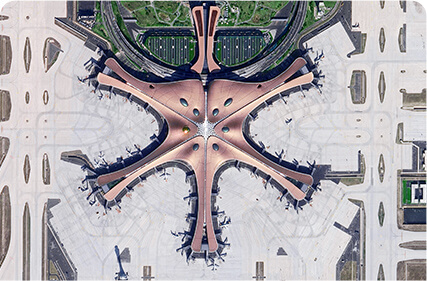English
Satellite remote sensing data acquisition and information extraction are very complicated processes. Different types of remote sensors also have significant differences. To better illustrate these two processes, let's take an example of using multispectral remote sensing to monitor tree growth.
The multispectral camera, as an optical remote sensor, can both image objects and measure their spectral characteristics. Different trees, such as pine, willow, banyan, phoenix, etc., have different spectral reflection characteristics in the visible and near-infrared spectrum, and their spectral characteristics also differ during different growth stages.
When the sunlight shining on these trees is reflected, their spectral characteristics are included in the reflection light. The multispectral camera mounted on the satellite platform can receive the reflected and scattered light from different trees, generate satellite remote sensing data containing both image and spectral information, and transmit the satellite remote sensing data back to the ground through signal modulation.
After the ground system receives the signal and processes it, it will transmit the image data to the remote sensing application system. This whole process is called the forward process of satellite remote sensing data acquisition.
This image data acquisition process is affected by various factors in multiple imaging links.
The sunlight passes through the atmosphere and reflects on the trees, and then it passes through the atmosphere again and reaches the entrance pupil of the multispectral camera. After being collected by the optical lens and detected by the detector, the reflected light generates digital signals which are then compressed and modulated before being sent back to the ground.
During this process, various factors will affect it, such as atmospheric absorption and scattering, turbulence, optical lens distortion, modulation transfer function (MTF), noise, stray light, error codes, etc.
After the ground system receives the data, it will go through signal demodulation, data decompression, relative radiation correction, atmospheric correction, image restoration, geometric correction, and other steps. Based on the single-band image data, the final image data products will be obtained by fusing the images of multiple spectral bands.
To extract information from the multispectral image data, it is necessary to calibrate the absolute radiation of the multispectral image data products and, according to the spectral reflection characteristics library of different trees, extract the tree growth status information of different times through inversion of the remote sensing application system, thereby obtaining tree distribution and growth status, and other information products. This is how the satellite remote sensing information extraction and inversion process is completed.
The process of extracting tree information from multispectral images is also very complicated and typically requires multiple steps:
The first step is to combine the spectral response characteristic curves and absolute radiation calibration data of the multispectral camera and reverse engineer the radiance brightness on the detector.
The second step is to reverse engineer the radiation rate at the entrance pupil of the camera based on the characteristics of the camera's optical part and the photovoltaic conversion characteristics parameters of the detector.
The third step is to determine the specific position of the tree by positioning each pixel on the ground surface using external orientation elements such as satellite attitude and internal orientation elements such as camera.
The fourth step is to reverse the ground spectral emission degree based on atmospheric conditions and atmospheric radiation transmission characteristics.
The fifth step is to reverse the spectral reflectivity of the tree based on the relative positions of the sun, ground, and satellite during imaging.
Finally, using the spectral reflectivity curve of different trees to extract tree distribution and growth status information.
It is worth mentioning that both the forward process of remote sensing data acquisition and the inversion process of extracting target information from remote sensing data require a deep understanding of their physical laws. The more thoroughly we understand the process of generating data from electromagnetic waves, the more precise the application model of information inversion will be, and the more useful information we can obtain.
